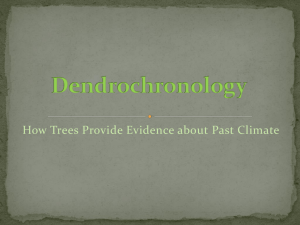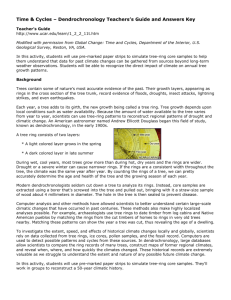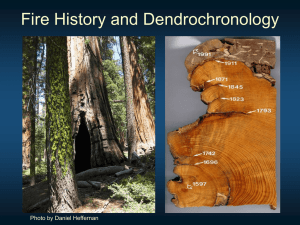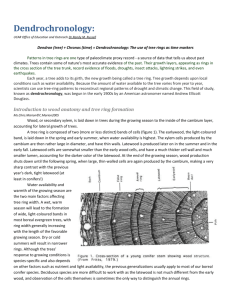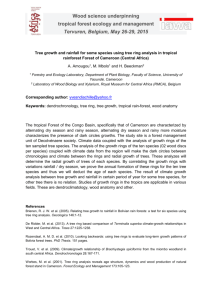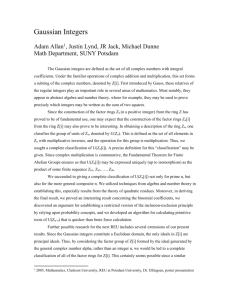Time & Cycles - Dendrochronology
advertisement
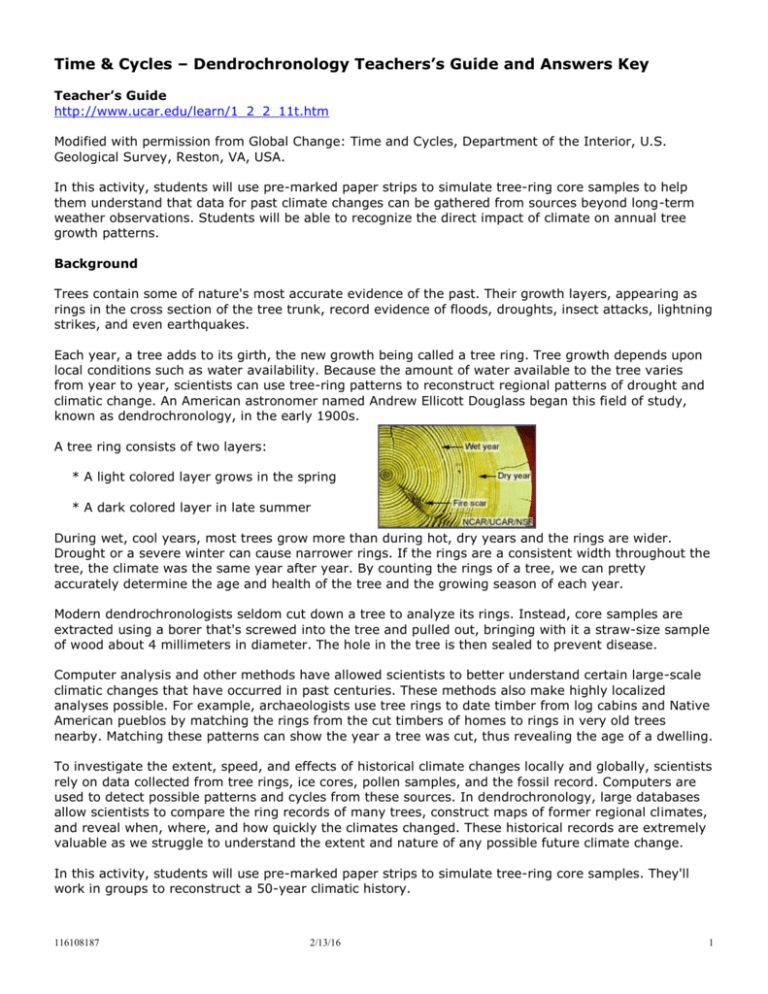
Time & Cycles – Dendrochronology Teachers’s Guide and Answers Key Teacher’s Guide http://www.ucar.edu/learn/1_2_2_11t.htm Modified with permission from Global Change: Time and Cycles, Department of the Interior, U.S. Geological Survey, Reston, VA, USA. In this activity, students will use pre-marked paper strips to simulate tree-ring core samples to help them understand that data for past climate changes can be gathered from sources beyond long-term weather observations. Students will be able to recognize the direct impact of climate on annual tree growth patterns. Background Trees contain some of nature's most accurate evidence of the past. Their growth layers, appearing as rings in the cross section of the tree trunk, record evidence of floods, droughts, insect attacks, lightning strikes, and even earthquakes. Each year, a tree adds to its girth, the new growth being called a tree ring. Tree growth depends upon local conditions such as water availability. Because the amount of water available to the tree varies from year to year, scientists can use tree-ring patterns to reconstruct regional patterns of drought and climatic change. An American astronomer named Andrew Ellicott Douglass began this field of study, known as dendrochronology, in the early 1900s. A tree ring consists of two layers: * A light colored layer grows in the spring * A dark colored layer in late summer During wet, cool years, most trees grow more than during hot, dry years and the rings are wider. Drought or a severe winter can cause narrower rings. If the rings are a consistent width throughout the tree, the climate was the same year after year. By counting the rings of a tree, we can pretty accurately determine the age and health of the tree and the growing season of each year. Modern dendrochronologists seldom cut down a tree to analyze its rings. Instead, core samples are extracted using a borer that's screwed into the tree and pulled out, bringing with it a straw-size sample of wood about 4 millimeters in diameter. The hole in the tree is then sealed to prevent disease. Computer analysis and other methods have allowed scientists to better understand certain large-scale climatic changes that have occurred in past centuries. These methods also make highly localized analyses possible. For example, archaeologists use tree rings to date timber from log cabins and Native American pueblos by matching the rings from the cut timbers of homes to rings in very old trees nearby. Matching these patterns can show the year a tree was cut, thus revealing the age of a dwelling. To investigate the extent, speed, and effects of historical climate changes locally and globally, scientists rely on data collected from tree rings, ice cores, pollen samples, and the fossil record. Computers are used to detect possible patterns and cycles from these sources. In dendrochronology, large databases allow scientists to compare the ring records of many trees, construct maps of former regional climates, and reveal when, where, and how quickly the climates changed. These historical records are extremely valuable as we struggle to understand the extent and nature of any possible future climate change. In this activity, students will use pre-marked paper strips to simulate tree-ring core samples. They'll work in groups to reconstruct a 50-year climatic history. 116108187 2/13/16 1 Learning Goals 1. Students will understand that data for past climate changes can be gathered from sources beyond long-term weather observations. 2. Students will recognize the direct impact of climate on annual tree growth patterns. Alignment to National Standards National Science Education Standards Life Science, Structure and Function in Living Systems, Grades 5 to 8, pg. 158, Item #4: "The number of organisms an ecosystem can support depends on the resources available and abiotic factors, such as the quantity of light and water, range of temperature, and soil composition. Lack of resources and other factors, such as predation and climate, limit the growth of populations in specific niches in the ecosystem." Benchmarks for Science Literacy, Project 2061, AAAS The Nature of Science, Scientific Inquiry, Grades 6 to 8, pg. 12, Item #1: "Scientists differ greatly in what phenomena they study and how they go about their work. Although there is no fixed set of steps that all scientists follow, scientific investigations usually involve the collection of relevant evidence, the use of logical reasoning, and the application of imagination in devising hypotheses and explanation to make sense of the collected evidence." The Nature of Science, Scientific Inquiry, Grades 6 to 8, pg. 12, Item #4: "New ideas in science sometimes spring from unexpected findings, and they usually lead to new investigations." Grade Level/Time Grade level: 6 to 8 Time: Preparing the paper strip samples: 15 minutes Lesson background: 20 minutes Student activity: 45 minutes Class discussion: 20 minutes Materials for Each Group of Four Students A set of paper strips pre-marked with ring patterns. (Attached at end of teacher materials). (A key has been provided on the following page). Make a copy for each group. Then cut the paper strips apart and (if you want to make them sturdier) glue them onto light cardboard or sturdy paper (file folders would work well too). For a more realistic sample 'core' you may want to consider using straws or wood dowels. Be aware that the preparation time will be much longer and more tedious. Transparent tape A worksheet 116108187 2/13/16 2 Student core samples KEY 116108187 2/13/16 3 Procedure Overview The graphic below shows how the Sample 1 and Sample 2 strips can be aligned. The students will align all four samples so that the patterns match. Then they'll determine the year when each tree was cut and when it began to grow. They'll count all of the rings from the oldest samples as they are aligned with the younger samples to determine the total amount of time represented by the rings. They should count aligned rings that appear on several samples only once. You many want to tell the students that the pith (central layer) and bark are not counted in determining the age of a sample. The youngest ring is closest to the bark and the oldest ring is closest to the pith. Activity 1. Group students in teams of four and distribute the paper strips and student guides. 2. Either write the following information on the blackboard or copy it and hand it out. This information is also included in the student guide. Imagine you have core samples from 4 trees: Sample 1: From a living tree from the Cedarville Forest, July 1993 Sample 2: From a tree from the Cedarville Christmas Tree Farm Sample 3: From a log found near the main trail in Cedarville Forest Sample 4: From a barn beam removed from Cedarville Hollow 3. Ask the students to determine the age of each tree (how many years it had been growing) by counting the rings. Then have them record their answers on the worksheet. The answers are provided below. 116108187 2/13/16 4 Sample Age of Tree Year Cut or Cored Year Growth Began 1 31 years 1993 1962 2 28 years 1990 1962 3 39 years 1988 1949 4 28 years 1970 1942 Analysis: Use complete sentences for full credit 1. How do trees record climatic information in their growth rings? As they grow, they produce different width rings depending on the climate that year. 2. What type of climate do wide rings indicate? Cool, wet – good for growing 3. What type of climate do narrow rings indicate? Drought, warm – not as good for growing 4. What was the total length of time that we have climate data for in Cedarville? 51 years Assessment Ideas Ask students the following: Why might a climatologist be interested in the tree-ring data from Pinetown? Is it likely to be more important to sample trees in the area that are quite old or ones that are fairly young? Why? Modifications for Alternative Learners Visually impaired students should be partnered with sighted students. 116108187 2/13/16 5 Time & Cycles - Dendrochronology Trees contain some of nature's most accurate evidence of the past. Their growth layers, appearing as rings in the cross section of the tree trunk, record evidence of floods, droughts, insect attacks, lightning strikes, and even earthquakes. Each year, a tree grows. The new growth is called a tree ring. How much the tree grows depends on such things as how much water was available. Because the amount of water available to the tree varies from year to year, scientists can use tree-ring patterns to reconstruct regional patterns of drought and climatic change. This field of study, known as dendrochronology, was begun in the early 1900s by an American astronomer named Andrew Ellicott Douglass. By counting the rings of a tree, we can pretty accurately determine the age and health of the tree anthe growing season of each year. Modern dendrochronologists seldom cut down a tree to analyze its rings. Instead, core samples are extracted using a borer that's screwed into the tree and pulled out, bringing with it a straw-size sample of wood about 4 millimeters in diameter. The hole in the tree is then sealed to prevent disease. In this activity, your teacher will give you samples that simulate tree-ring cores. Your group will be given four simulated tree-ring cores. The samples came from the following sources: Sample 1: From a living tree from the Cedarville Forest, July 1993 Sample 2: From a tree from the Cedarville Christmas Tree Farm Sample 3: From a log found near the main trail in Cedarville Forest Sample 4: From a barn beam removed from Cedarville Hollow Procedure Part 1: How old is tree number 1? 1. Since you know when this tree was cored (1993), starting with the current age, you can determine the age of the tree by counting the rings from the bark to the pith. Count the rings carefully, remembering that each ring represents one year of growth. 2. Remember, the pith (central layer) and bark are not counted in determining the age of a sample. 3. And, the youngest ring is closest to the bark and the oldest ring is closest to the pith. 4. Record the tree age in the data table below. Part 2: When did tree number 1 start growing? 1. Sample 1 was cored in 1993, meaning that the outer ring grew that year. How can you tell what year Sample 1 started growing? Figure that out and record the year in the data table for Sample 1. (Hint: use subtraction) 116108187 2/13/16 6 Part 3: Figuring out the ages of the other trees (A difficult task) 1. Samples 2, 3, and 4 were cut down before their tree ring core was taken - but we don't know exactly when. How can we figure out both the year they were cut and the year they started growing from the tree ring cores? 2. To accomplish this task, look at all four cores. First, look for a pattern in the rings - some are wide and some are narrow. (Remember: Wide rings indicate that the tree was growing fast that year, probably because the weather was good. Narrow rings indicate slow growth, probably linked to regional drought or cold temperatures.) All of these trees were growing in the same general area, so if they were alive at the same time, they should show the same ring patterns. Once you have found some pattern matches, line up the cores so that the patterns overlap. The picture below should help guide you. Figure 1: Example of pattern matching in the tree cores. (Note that our patterns won’t look like this.) Once the cores are lined up, here's how you can determine their ages: You know that 1992 is the last ring on Sample 1. Count backward until you get to the ring that matches on another core. That ring was produced in the same year on both cores. Now you can count backward on this core until you reach the first matching ring on the next core. Those rings were produced in the same year as well. Repeat for the last core. Now simply count backward to the end of the cores and you have the year the trees began to grow. Record all data in the data table. Data Table 1 Sample Age of Tree 1 Year Cut or Cored Year Growth Began 1993 2 3 4 116108187 2/13/16 7 Analysis: Use complete sentences for full credit 5. How do trees record climatic information in their growth rings? 6. What type of climate do wide rings indicate? 7. What type of climate do narrow rings indicate? 8. What was the total length of time that we have climate data for in Cedarville? 116108187 2/13/16 8 116108187 2/13/16 9 Dendrochronology and the Orphan Tsunami of the 1700 Cascadia Subduction Zone Earthquake Teacher Guide and Key Background This activity pairs well with the previous and connects dendrochonology with the orphan tsunami story in the Pacific Northwest. Much of the background is taken from the Pacific Northwest Seismic Network website (http://www.pnsn.org/HAZARDS/CASCADIA/cascadia_event.html) In this activity, students will be using sample tree-ring cores from the roots of trees that died as a result of the tsunami generated by the 1700 Cascadia Subduction Zone earthquake. They will be comparing these sample tree-rings with a composite-ring set taken from living/recently cut trees. That record is nearly 1000 years old. Similar to what students completed in the previous activity (Time & Cycles – Dendrochronology), students will match the tree ring data from their samples and compare it with the composite-ring set in an attempt to find the year that trees from the ghost forest died. Grade Level/Time Grade level: 6 to 8 Time: Preparing the paper strip samples: 15 minutes Lesson background: 20 minutes Student activity: 45 minutes Class discussion: 20 minutes Materials for Each Group of Four Students A set of paper strips pre-marked with ring patterns. (Attached at end of student materials). Make a copy for each group. Then cut the paper strips apart and (if you want to make them sturdier) glue them onto light cardboard or sturdy paper (file folders would work well too). For a more realistic sample 'core' you may want to consider using straws or wood dowels. Be aware that the preparation time will be much longer and more tedious. Transparent tape A worksheet Activity 1. Group students in teams of four and distribute the paper strips and student guides. 2. Ask the students to determine the year that each tree died. This is completed by comparing the ring pattern on each of the samples with ring pattern on composite-ring pattern and then counting either up or down in years to find the last year of growth. In all cases, the sample trees died in 1699. The table is completed below: Tree Core Sample 1 Year of Death 1699 Sample 2 1699 Sample 3 1699 Sample 4 1699 116108187 2/13/16 10 Analysis 1. What is a “ghost forest” and how does it form? The ghost forests are composed of large, dead, cedar trees. These trees could not have grown in their current brackish-water setting and they had not been killed by fire. It appeared that they had died because their roots became submerged in brackish water and covered by mud and the trees quickly died. The trees and other plants living near them died so quickly and were so well preserved by mud that they appear to have died yesterday. 2. Where are four places to visit “ghost forests” in the Pacific Northwest? the Copalis River, Grays Harbor, Willapa Bay, and the Columbia River 3. How many years does the entire composite ring-width pattern cover? 1986 – 993 = 993 years some students will be tempted by: 1715-1685 = 30 years this is NOT the entire record 4. What year did all of the trees sampled die? Is this the same year as the earthquake? Explain. 1699 No, the earthquake occurred in 1700. With the Japanese oral history there is evidence that the earthquake occurred January 26, 1700. This is during the winter in the northern hemisphere and these trees were not growing during that time, so their last year of growth was 1699 and they were drowned in the winter of 1700, never producing a 1700 year growth ring. 116108187 2/13/16 11 Dendrochronology and the Orphan Tsunami of the 1700 Cascadia Subduction Zone Earthquake While dendrochronology is very useful for climatic studies, it has also proven useful in understanding the geology of the Pacific Northwest. As Brian Atwater and his colleagues were putting together the story of the last great Cascadia Subduction Zone earthquake and tsunami, one of the challenges was trying to put a date on the event. They had evidence that the earthquake and tsunami had occurred. A great piece of evidence for the tsunami was in the “ghost forests” of Willapa Bay, Washington. The ghost forests are composed of large, dead, cedar trees. These trees could not have grown in their current brackish-water setting and they had not been killed by fire. It appeared that they had died because their roots became submerged in brackish water and covered by mud and the trees quickly died. The trees and other plants living near them died so quickly and were so well preserved by mud that they appear to have died yesterday. But the question was: When? To date the occurrence of this tree-killing event, 19 living trees with consistent ring patterns were sampled. The composite ring-width pattern of these 19 trees spanned from 993 to 1986. Next, trunk rings of 75 snags from the Copalis River, Grays Harbor, Willapa Bay, and the Columbia River were matched with the composite ring-width pattern of the 19 living trees. From this comparison, tree-ring sequences from the dead snags are matched to sequences within the lifespan of trees of a known age. Most of the ghost trees were shown to have died sometime after the 1680's, though the outer rings of the snags had been eroded away due to exposure to rain and wind, and an exact year of death could not be determined. Then a few years later, bark-covered roots complete to the outer rings were found! Your job is to help determine a more precise age for this event by looking at the barkcovered roots complete to the outer rings that have recently been recovered from four of the correlated snags. Below is part of the composite-ring-width pattern showing ring widths from 1685 to 1715 and the four snags. Your instructor will provide you with a larger scale version of these. 116108187 2/13/16 12 Finding the year of death of the “Ghost Trees” Samples 1, 2, 3, and 4 were all taken from the roots of trees that are part of the ghost forests in western Washington. Procedure: To find the year that these trees died, follow the procedure below: 1. You know that the trees died between 1685 and 1715 and each ring represents one year of growth. 2. Look at the first core. First, look for a pattern in the rings - some are wide and some are narrow. All of these trees were growing in the same general area, so if they were alive at the same time, they should show the same ring patterns. Once you have found some pattern matches, line up the first core so that the patterns match with the composite-ring core. (This is similar to what you did in the previous exercise). 3. Once the cores are lined up, here's how you can determine the year that they died: Count up from 1685 on the composite-ring core to the last growth ring of the tree in the sample. (Remember not to count the bark!) (Hint: Sometimes it might be easier to count backwards from 1715.) 4. Record the year of death in the table provided. 5. Repeat the process of lining up patterns and counting rings for each of the samples. 6. Record the year of death in the table provided. Data: Tree Core Sample 1 Year of Death Sample 2 Sample 3 Sample 4 Analysis 4. What is a “ghost forest” and how does it form? 5. Where are four places to visit “ghost forests” in the Pacific Northwest? 6. How many years does the entire composite ring-width pattern cover? (Show your work!) 4. What year did all of the trees sampled die? Is this the same year as the earthquake? Explain. 116108187 2/13/16 13 116108187 2/13/16 14
